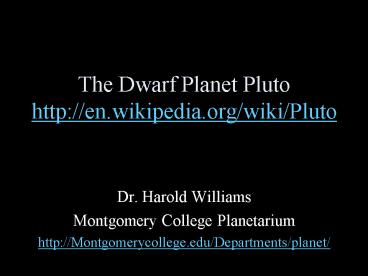The Dwarf Planet Pluto http:en.wikipedia.orgwikiPluto - PowerPoint PPT Presentation
1 / 34
Title:
The Dwarf Planet Pluto http:en.wikipedia.orgwikiPluto
Description:
... orbit in a belt between Mars and Jupiter. Trojan asteroids follow ... Now other large objects have been discovered in Kuiper Belt, including 'Planet X' ... – PowerPoint PPT presentation
Number of Views:285
Avg rating:3.0/5.0
Title: The Dwarf Planet Pluto http:en.wikipedia.orgwikiPluto
1
The Dwarf Planet Plutohttp//en.wikipedia.org/wik
i/Pluto
- Dr. Harold Williams
- Montgomery College Planetarium
- http//Montgomerycollege.edu/Departments/planet/
2
Clyde Tombaughdiscover of Pluto
3
Lowell Observatory Astrograph
4
Lowell Observatory Blink Comparator
5
(No Transcript)
6
(No Transcript)
7
(No Transcript)
8
Ganymede (Jupiter), Titan (Saturn) and Callisto
(Jupiter) Io (Jupiter), Luna (Earth), Europa
(Jupiter), Triton (Neptune) and Pluto.
9
(No Transcript)
10
(No Transcript)
11
Asteroid Orbits
- Most asteroids orbit in a belt between Mars and
Jupiter - Trojan asteroids follow Jupiters orbit
- Orbits of near-Earth asteroids cross Earths orbit
12
(No Transcript)
13
Wikipedia Links
- http//en.wikipedia.org/wiki/Minor_planet
- http//en.wikipedia.org/wiki/Minor_Planet_Center
- http//en.wikipedia.org/wiki/Minor_planet_number
- http//en.wikipedia.org/wiki/Eris_28dwarf_planet
29 - http//en.wikipedia.org/wiki/Trans-Neptunian_objec
t - http//en.wikipedia.org/wiki/Asteroid
- http//en.wikipedia.org/wiki/List_of_asteroids_nam
ed_after_important_people
14
(No Transcript)
15
Only a tiny number of comets enter the inner
solar system - most stay far from the Sun
Oort cloud On random orbits extending to about
50,000 AU
Kuiper belt On orderly orbits from 30-100 AU in
disk of solar system
16
How big can a comet be?
17
Plutos Orbit
- Pluto will never hit Neptune, even though their
orbits cross, because of 32 orbital resonance - Neptune orbits three times during the time Pluto
orbits twice
18
Is Pluto a Planet?
- By far the smallest planet.
- Not a gas giant like other outer planets.
- Has an icy composition like a comet.
- Has a very elliptical, inclined orbit.
- Pluto has more in common with comets than with
the eight major planets
19
Other Icy Bodies
- There are many icy objects like Pluto on
elliptical, inclined orbits beyond Neptune. - The largest of these, Planet X was discovered
in summer 2005, is even larger than Pluto
20
Kuiper Belt Objects
- These large, icy objects have orbits similar to
the smaller objects in the Kuiper Belt that
become short period comets - So are they very large comets or very small
planets?
21
What are the large objects of the Kuiper belt
like?
22
HSTs view of Pluto Charon
23
What is Pluto like?
- Its moon Charon is nearly as large as Pluto
itself (probably made by a major impact) - Pluto is very cold (40 K)
- Pluto has a thin nitrogen atmosphere that will
refreeze onto the surface as Plutos orbit takes
it farther from the Sun.
24
Other Kuiper Belt Objects
- Most have been discovered very recently so little
is known about them. - NASAs New Horizons mission will study Pluto and
a few other Kuiper Belt object in a planned
flyby.
25
Is Planet X a planet?
26
Pluto and Planet X
- Plutos size was overestimated after its
discovery in 1930 - It was considered a planet, and nothing of
similar size was discovered for several decades - Now other large objects have been discovered in
Kuiper Belt, including Planet X - Some scientists consider all of those objects
planets others consider none of them planets.
27
Sedna in Green Circlehttp//en.wikipedia.org/wiki
/90377_Sedna
28
(No Transcript)
29
What have we learned?
- How big can a comet be?
- The Kuiper belt from which comets come contains
objects as large as Pluto. - What are the large objects of the Kuiper belt
like? - Large objects in the Kuiper belt have orbits and
icy compositions like those of comets. - Is Planet X a planet?
- It remains a matter of opinion because scientists
have not yet settled on a definition of the
minimum size of a planet.
30
New Horizons Spacecraft
- http//en.wikipedia.org/wiki/New_Horizons
- Major Contractors JHU APL, SwRI
- New Horizons NASAs Pluto-Kuiper Belt Mission
http//pluto.jhuapl.edu/
31
New Horizonslaunched January 19, 2006flyby
Pluto July 14, 2015
32
Spacecraft New Horizons
33
Thermal Space Battery
34
Antennas of New Horizons (HGA, MGA and LGA)































